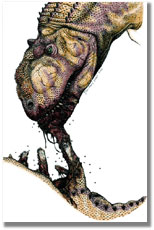 |
 Evidence
of Cannibalism among Dinosaurs Evidence
of Cannibalism among Dinosaurs
|
 |
 |
Artistic rendering of the theropod dinosaur
Majungatholus atopus feeding from the remains of a
conspecific.
Artwork by Demetrios M. Vital |
Dinosaur
Cannibal Unearthed in Madagascar
The exotic island of Madagascar, situated off the southeast coast
of Africa, was a dangerous place to live 65 million to 70 million
years ago. Crocodiles swarmed in the rivers, and a 30-foot-long,
meat-eating dinosaur named Majungatholus atopus stalked
the plains. Like most carnivorous dinosaurs, Majungatholus
had teeth perfectly suited for ripping into flesh. But what was
on the menu? Until now, this question has remained a mystery. In
a report published in the April 3 issue of the journal Nature,
Raymond Rogers, a geologist from Macalester College in St. Paul,
Minnesota, along with colleagues David Krause of the State University
of New York at Stony Brook and Kristina Curry Rogers of the Science
Museum of Minnesota, provide an answer. Majungatholus was a cannibal--it
regularly dined upon members of its own species. It also fed upon
the remains of other dinosaurs, including gigantic long-necked sauropods
called titanosaurs.
More... (posted
April 4, 2003)
|
 |
|
 |
|
Liberty Bell Passes
Stress Test
How do you move a wounded, 2,080-pound patriot? Very carefully.
Recently, under the watchful eyes of curators, conservators, surveyors,
and engineers, a team of riggers deftly lifted the fragile Liberty
Bell off of the supports on which it has been resting for a quarter
century and confirmed the bell can be safely moved into its new
home this fall. Recognizable across the globe with its famous crack,
the 250-year-old bell is remarkably frail for its size. Although
the bell will move only 200 yards into the new museum, curators
are taking every precaution to assure its safety. Steve Arms, president
of MicroStrain, Inc., tracked movements of the metal along the crack
using tiny, wireless sensors he developed as part of the NSF Small
Business Innovation Research program. The devices are extremely
sensitive, able to detect motion as small as 1/100th the width of
a human hair. The researchers used custom attachments to place two
metal sensors, originally developed for the semiconductor industry,
on the metal around the bell's main crack. The team also hung a
third sensor inside the bell to monitor potentially jarring rocking
motions.
More... (posted
April 4, 2003)
|
 |
|
 |
|
Forest Fragmentation
May Increase Lyme Disease Risk
Patchy woods -- common in cities and suburbia, and even in rural
areas -- may have more Lyme disease-carrying ticks, which could
increase risk of the disease in these forest remnants, scientists
have found. While forest fragments generally have fewer species
than continuous habitat does, some species actually fare better
in small patches, according to biologist Felicia Keesing of Bard
College in Annandale, NY, and her colleagues. Lyme disease incidence
is rising in the United States, and is in fact far more common than
West Nile fever and other insect-borne diseases. Forest fragmentation
could explain the increase. "This research is important because
it gives us a new way of looking at the transmission of diseases,
and shows us that human health is affected by the local ecology,
and by land-use practices," said Michael Bowers, program director
in the National Science Foundation (NSF)'s division of environmental
biology, which funded the research.
More... (posted
April 4, 2003)
|
 |
|
 |
| Light Echo from Star V838 Monocerotis This sequence of pictures from the NASA Hubble Space Telescope's Advanced Camera for Surveys dramatically demonstrates the reverberation of light through space caused by an unusual stellar outburst in January 2002.
Credit: PHOTO NO.: STScI-PRC03-10 courtesy of NASA, ESA and H.E. Bond (STScI) |
Researchers Spy Stellar
Bull's Eye; Dramatic images reveal unique star explosion
In the early months of 2002, astronomers scanning the sky saw something
highly unusual - and they still don't know exactly what it is. A
star suddenly flashed to 600,000 times its previous brightness.
For a brief time, it was the brightest star in the galaxy. As the
light from the outburst spread into space, it reflected from surrounding
rings of dust to reveal a spectacular, multicolored bull's eye that
is now 3 light years across and still growing. "This is such
an exciting discovery," said NSF-supported astronomer Sumner
Starrfield of Arizona State University, one of the researchers reporting
the discovery in the March 27 Nature. "It was like a light
bulb going off, and you can see the light echoing off surrounding
material."
More... (posted April 4,
2003)
|
 |
| |


|

